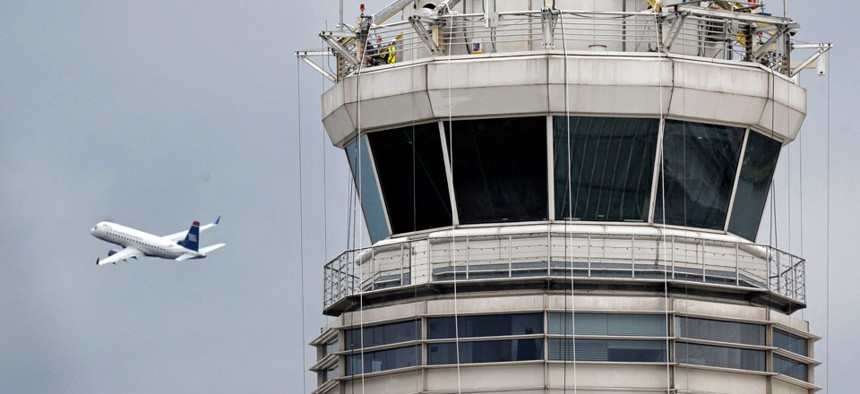Management Failures Threaten New Air Traffic Control Navigation System

A passenger jet flies past the FAA control tower at Washington's Ronald Reagan National Airport. Cliff Owen/AP File Photo
FAA plans were unrealistic and the project has lacked leadership, report says.
A series of management and scheduling failures are threatening the successful deployment of a $40 billion project to transform the country’s air traffic control system to GPS-based guidance from a ground-based system, according to a new report.
The Federal Aviation Administration’s inability to set realistic plans and budgets, gaps in leadership, and delays in development of key systems are hindering the Next Generation Air Transportation System, known as NextGen, the Transportation Department’s inspector general warned in a report on top challenges for 2014.
FAA’s NextGen plan lacks sound strategies for achieving the system that aims to handle three times more traffic while reducing the agency’s operating costs, the IG said. The agency has been unable to set realistic plans, budgets, and expectations for key NextGen programs due to a lack of firm requirements for its most critical capabilities, the IG added.
FAA’s organizational culture has also been slow to embrace its transformational vision, and gaps in leadership have further undermined the agency’s efforts to advance NextGen, the report said.
FAA did create a new management slot -- NextGen assistant administrator -- with top level oversight. Raymond Bolton, a retired Air Force major general who also served as a Defense Department deputy assistant secretary, signed on as the top NextGen administrator in September.
FAA also set up a new NextGen program management office to oversee the project, which started in 2004 with final deployment scheduled in 2025. “While these changes could enhance FAA’s management of NextGen, it remains unclear whether they will be sufficient to successfully implement NextGen.” the IG concluded in its report.
The IG said FAA still lacks a master schedule for the complex projects, which include replacing ground based radars with a GPS navigation system that will require new equipment in aircraft and upgrades to FAA infrastructure. This involves a $2.5 billion modernization of hardware and software at facilities that manage high-altitude traffic and a $1 billion project to upgrade computer displays and processors that manage take-offs and landings.
FAA plans to start using an integrated master schedule in March to coordinate development of the GPS system, along with new voice, data and weather systems, the IG said.
The high-altitude system, En Route Automation Modernization, experienced “significant delays and cost increases due to extensive software-related problems,” but the IG said FAA is now using these systems at 15 out of 17 designated facilities, with final deployment by March 2015.
FAA plans to install “terminal automation modernization and replacement” hardware to manage take-offs and landings at 11 traffic control facilities in 2017, though the agency has not yet finalized all its hardware and software requirements, the IG said.
The agency estimated in 2012 that aircraft owners and operators will need to invest $19 billion to buy and install the avionics hardware required to work with NextGen. The IG said that until FAA “clearly demonstrates the type and timing of expected benefits” from NextGen, airlines and other aircraft operators will “remain reluctant” to make such a sizeable investments.
To date, NextGen Performance Based Navigation Systems, which help eliminate airport holding patterns, have only been adapted for use in small and medium sized airports, the IG said. Use of these systems in large airports has been stymied by lack of policies and procedures for controllers and lack of controller tools, the IG said.
The FAA requested a budget of just more than $1 billion for NextGen in 2014, with the final budget determined by its appropriation bill, tied to passage of the overall 2014 federal budget.



